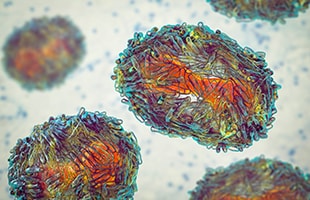Highlights
- The National Syndromic Surveillance Program (NSSP) has supported the nation's mpox response since 2022.
- NSSP collaborates with infectious disease experts and epidemiologists nationwide to guide mitigation efforts.
- NSSP makes tools and processes available to support public health decision-making.

Full story
Through its partnerships with state and local health departments and CDC programs, NSSP has supported the nation's response to mpox outbreaks since 2022. NSSP's emergency department (ED) data, collected before cases are diagnosed or laboratory results are confirmed, have helped public health at all levels to detect, monitor, and guide mitigation efforts for these health events.
The symptoms of mpox can include:
- Fever
- Headache
- Muscle aches and backache
- Swollen lymph nodes
- Chills
- Exhaustion
- Rash
State and local participants in NSSP—most of whom collaborate through the NSSP Community of Practice—routinely monitor ED data to identify potential cases and visits by people seeking care for many of these symptoms.
The NSSP Community of Practice comprises a group of dedicated analysts, epidemiologists, and public health practitioners who collaborate across public health jurisdictional lines to share information about health threats and emerging disease. NSSP facilitates their efforts by making sure the tools and processes to analyze, share, and report on data are available. NSSP works to ensure syndromic surveillance remains a source of high-quality data to support public health decision-making.
Mpox monitoring resumes
NSSP support
NSSP support for the mpox response has been wide-ranging, including:
- Supporting state and local public health practitioners in their case-finding efforts. Public health practitioners search visits with a mention of mpox or an mpox diagnosis for follow-up investigation.
- Monitoring emergency department visit trends in consultation with partners in state and local health departments and clinical subject experts. NSSP uses data from electronic health records to look for mpox diagnosis and find mentions of mpox in the text of chief complaint, rash-fever ED presentations not attributed to conventional rash- or fever-producing conditions, and other broad areas of rash, including genital lesions.
- Uniting the NSSP Community of Practice. To answer the question of whether mpox might have been circulating undetected before it was widely recognized in 2022, the NSSP team collaborated with partners in state and local health departments to conduct trend analysis of the available data. Participants joined working calls and used a collaborative communication platform to rapidly share analyses, insights, and questions with surveillance experts across the nation.
- Monitoring data from one large national commercial laboratory that sends electronic data in near real time. NSSP receives this lab's orthopoxvirus test orders and results and makes the information available to NSSP participants. NSSP also looks for increases in testing volume for conditions with similar presentation to mpox but not positive for those conditions.
- Supporting state and local health departments' use of data. NSSP provides health departments with all the essential tools needed to conduct syndromic surveillance and to analyze, visualize, and share findings.
